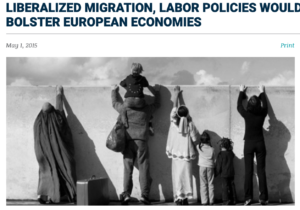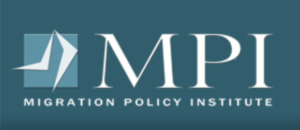Europe: Long and Complicated Migrations
NCFCA policy debaters face a challenging resolution: The European Union should substantially reform its immigration policy. Europe, of course, has a long history of people migrating from region to region and country to country. For centuries millions emigrated, migrated out of Europe for opportunities in North and South American, Australia and elsewhere around the world.
European borders have shifted dramatically over the centuries though both war and diplomacy. Most recently Eastern and Western Europe were reunited with the fall of the Iron Curtain as the Cold War ended and communism collapsed in Eastern Europe and the USSR. Millions migrated from countries made poor by decades of communism to wealthy western Europe.
Here is a glimpse of Europe’s shifting borders through the centuries: Animation: How the European Map Has Changed Over 2,400 Years.
Europeans on the Move
After the Cold War ended, the UK opened to immigration from Poland and soon news stories were full of complaints about “Polish plumbers.” Some two million have migrated from Poland to the UK, Germany, France, and Ireland since the fall of communism in 1989. But consider an earlier chapter from European migration. In 1600 though Scotland’s population was 800,000 , tens of thousands had relocated to Poland. From the Scotland and Poland website:
By the 1600s there were an estimated 30,000 Scots living in Poland. Many came from Dundee and Aberdeen and could be found in Polish towns from Krakow to Lublin. Settlers from Aberdeenshire were mainly Episcopalians or Catholics, but there were also large numbers of Calvinists. As well as Scottish traders there were also many Scottish soldiers in Poland.
The Scots integrated well and many acquired great wealth. They contributed to many charitable institutions in the host country, but did not forget their homeland…
Many Royal Grants and privileges were granted to Scottish merchants until the 1700s at which time the settlers began to merge more and more into the native population. Bonnie Prince Charlie was half Polish, being the son of James Edward Stewart and Clementina Sobieska, granddaughter of Jan Sobieski, King of Poland.
Through history people have migrated from poor countries to wealthier countries. Relative economic freedom leads to faster economic growth, higher wages, and more employment and more opportunities for entrepreneurs.
Religious differences drive migration. French Huguenots became one-fifth of Berlin by 1700:
Louis XIV revoked the Edict of Nantes, which had protected the rights of Calvinist Protestants in France, by signing the Edict of Fontainebleau on October 22nd, 1685.[3] Just one week later, the Duke of Prussia Friedrich Wilhelm issued the Edict of Potsdam which promised autonomy, privileges, and economic support for French religious refugees in his territories.[4] Of around 250,000 French protestants who fled, approximately 20,000 came to Brandenburg-Prussia, and refugees made up 20% of Berlin’s population in 1700.[5] Over the course of centuries, the Huguenot community of Berlin slowly acculturated to a new way of life, though not without first impacting German society in significant ways. French Huguenots in Berlin: Acculturation and Nationalism (Politics in Theory and Practice, March 24, 2019)
High fertility rates across German states led to steady out-migration. In 1763 Catherine the Great invited German migrants to Russia:
On July 22nd, 1763, a young woman sat down at a neat little table in the cabinet of Peterhof Palace close to Petersburg, got out a quill and signed a ‘ukaz’, a decree. “We, Catherine the second, Empress and Autocrat of all the Russians at Moscow, Kiev, Vladimir … We permit all foreigners to come into Our Empire, in order to settle in all the governments, just as each one may desire.” The Manifesto is now kept in Russia’s state archive. …
In her typical poignant style, Catherine the Great described the treasures of her empire with all its rivers and lakes in her manifesto as well as “an inexhaustible wealth of all kinds of precious ores and metals” waiting “hidden in the depth.” She also wrote that she hoped for the “development and growth of many kinds of manufacturing, plants, and various installations.” Her goal was to stimulate population growth and productive use of “uncultivated” regions.
Catherine promised economic and religious freedom and:
In the course of the first five years, as many as 30,000 people came to Russia, most of them from what is today Germany. They settled in the St Petersburg area, in Southern Russia, on the Black Sea and along the Volga river. In the Volga region alone, 100 new villages emerged.
European borders closed for World War I. Before WWI there were no restrictions on the freedom of movement. Passports were invented as a temporary wartime measure. This 2011 article gives some history, Free Movement in Europe: Past and Present (Migration Policy Institute):
Prior to the start of World War I in 1914, there were virtually no border controls or restrictions to labor mobility across the continent. During the war, however, the crossing of borders by foreigners began to be considered a security concern, and it was at this time that passports and visas were introduced in Europe.
Then after WWII ended and the German Economic Miracle began, demand for labor increased:
Over 8 million work permits were issued to foreigners in Belgium, France, Italy, Luxembourg, the Netherlands, and West Germany (the original six members of the EEC) during the guest-worker period of 1958 to 1972. One-third of the foreign workers came from within the EEC; mainly from Italy, which was lagging behind in industrialization and suffered from high unemployment.
Workers were recruited through bilateral agreements from outside of Europe as well, especially to work in dirty, dangerous, and dull — the so-called 3D — jobs in the building, mining, and transportation sectors. Significant numbers of guest workers, for example, migrated from Turkey to Germany, from Algeria to France, and from the British Commonwealth countries to Britain. (MPI source).
After the fall of communism, the European Union expanded to include formerly communist European countries, which, with fifty years of communism, where much, much poorer.
In May 2004, the 15 states of the European Union (EU-15) welcomed ten new Member States in what was the largest expansion in the history of European integration.
The new Member States included eight countries (also called the A-8) from the other side of the former Iron Curtain: Czech Republic, Hungary, Poland, Slovakia, Slovenia, and the three Baltic states of Estonia, Latvia, and Lithuania, which had still been part of the Soviet Union just 13 years earlier. At the same time, membership was granted to the island states of Cyprus and Malta.
All the above is background for the NCFCA topic on reforming E.U. immigration policy, and the same economic principles apply to current and future migration. People living in poor countries want better opportunities for themselves and their families. Most people are content to stay home, except in the face of conflicts and famine.
The causes of conflicts and famines is therefore relevant to E.U. immigration and refugee policies going forward.
• LIBERALIZED MIGRATION, LABOR POLICIES WOULD BOLSTER EUROPEAN ECONOMIES (Atlas Network, May 1, 2015)
Europe is in the middle of a severe immigration crisis, with waves of migrants washing up on Mediterranean shores from North Africa. Migrants arrive in shoddy boats, filled to the brim with desperate people looking for a safe haven and a better life. Many of them are refugees escaping turmoil in the Middle East, particularly Syria and Libya, but the majority originate from sub-Saharan Africa. Mediterranean countries, particularly Italy and Spain, bear the brunt of the current crisis — not long after beginning to find their feet again after the recent economic downturn.
The economic and immigration crises throughout Europe are making many people rethink the European Union’s immigrations policies, but, if history is any guide, these policies will probably become even more restrictive, not less. Sam Bowman, deputy director of Atlas Network partner the Adam Smith Institute, suggests that this crisis would not be so painful for Europe if policymakers were to liberalize migration laws and the labor market.
Bringing in low-skilled immigrants who can fill positions in a flexible and absorbent labor market results in positive impacts on wages and productivity for natives, Bowman argues, while dramatically improving the lives of both the immigrants and their families back home. This should be a no-brainer for progressives who want to improve human welfare, but they face a dilemma. Researchers at Queen’s University found a negative correlation between the size of the welfare state and the propensity to lower the drawbridge.
• The Coronavirus Is Killing Globalization as We Know It (Foreign Policy, March 12, 2020):
The coronavirus crisis has highlighted the downsides of extensive international integration while fanning fears of foreigners and providing legitimacy for national restrictions on global trade and flows of people.
• See also the Migration Policy Institute’s Europe page. Recent  articles:
articles:
• A Race Against the Clock: Meeting Seasonal Labor Needs in the Age of COVID-19
